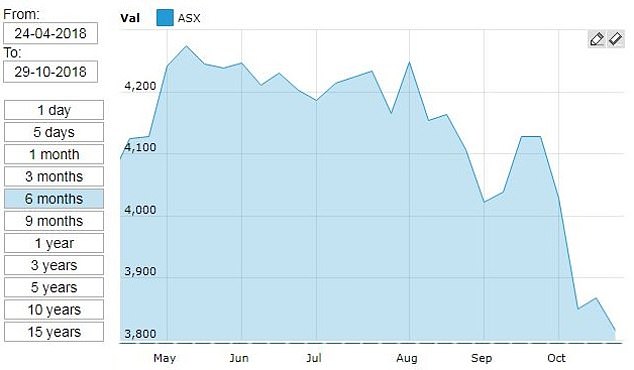Donald Trump’s trade war, the Fed ‘going loco’ with rate rises, Italy’s intransigence, or the concentric circles of Brexit – there are plenty of things to blame for stock markets sliding.
Whichever villain you choose – and it may be some, all, or none of these – there’s a shift in the stock market music worth noting.
The FTSE All Share index, a broad measure of the UK market, has dropped 6 per cent since the start of October and is down 10 per cent on its peak in spring this year.



What can investors do in stormy markets? One option is to look for funds that offer some protection and some even rose in 2008
So, what can we do as investors if this kind of thing worries us?
One option is to adopt the Buffett mantra of being greedy when others are fearful and buy more while the stock market is on sale.
Understandably, if your worry is that shares will suffer a 30 per cent fall and we’re only down 10 per cent now, this may not be your chosen course of action.
Instead, you could look at shifting your investing style to adapt to a more volatile world.
Traditionally, the way of doing this would be to up your bond exposure and a cheap easy passive option for that would be a Vanguard Lifestrategy fund further up the bonds to shares scale.
But the bond market is a dangerous place to tread, thanks to mass purchases through quantitative easing warping prices, so I’d prefer an active approach.
Working on the basis that I’d still want to be holding shares for their better chance of a higher total return, my thoughts are that it’s best to hunt in two areas:
Managers backing things that are cheaper, with a value or contrarian stance, thus providing some insulation against the disappointment that can send highly-rated growth stocks crashing.
Funds or investment trusts with a defensive outlook. Among these, on my list to consider are Personal Assets, which I bought earlier this year and we look at here, and Ruffer, Capital Gearing and RIT Capital Partners investment trusts, while on the fund side, those such as Baillie Gifford’s Managed Fund, Premier’s Multi-Asset Growth & Income, or similar, may be worth a look.
All of these trusts and funds adopt a cautious approach, balancing their investment in shares around the world with bonds and other assets that should bolster performance when the going gets tough.

None are likely to match the stock market’s performance over recent years, when conditions have been benign, but they do tend to have enviable records when markets fall.Â
Capital Gearing, for example, made money in 2008 at the height of the financial crisis, while Personal Assets fell just 3.4 per cent that year before rising 19.4 per cent in 2009 and says, ‘its investment policy is to protect and increase (in that order) the value of shareholders’ funds per share over the long term’.Â
Ruffer managed to position itself to not only dodge the stock market falls of 2008 but rise 23 per cent that year, by holding a large amount of the portfolio in index-linked bonds.Â
That same trick may not be possible again, but I am interviewing one of Ruffer’s managers, Duncan MacInnes, for This is Money’s Investing Show videos next week, so will ask him how it is protecting itself now and you can watch the interview soon.
The other option – and my main one so far is to keep it simple and counterweight my share investments with some cash.Â
The advantage of this being that it will be there ready and waiting for you if the market does take a big fall and you’re brave enough to buy where others fear to tread.